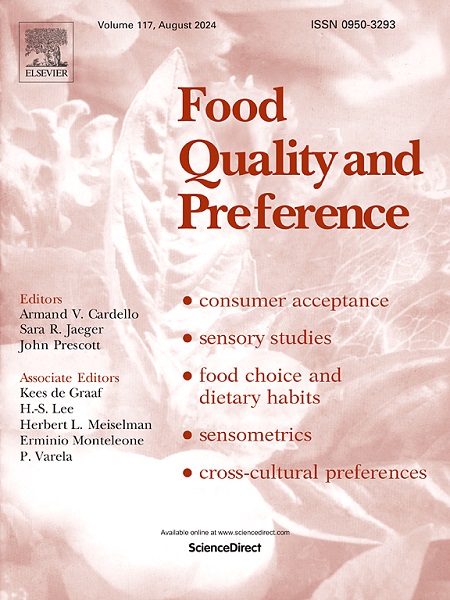嗅觉引物对食物概念心理表征和后续食物选择的影响
IF 4.9
1区 农林科学
Q1 FOOD SCIENCE & TECHNOLOGY
引用次数: 0
摘要
以往的研究表明,食物气味可以作为一种诱因,影响人们对食物的选择。人们对气味如何刺激(健康)食物选择知之甚少。我们假设,气味可以激活食物概念的心理表征,与食物决策的认知过程相互作用。我们通过研究哪些概念(健康、感官或特定产品)会被气味激活,以及这对随后的食物选择有何影响来验证这一假设。在主体间设计中,112 名参与者被分为三个条件:健康气味(苹果或香蕉)、不健康气味(巧克力或焦糖)和无味(对照)。参与者在一种条件下暴露 5 分钟,然后完成词汇决策任务和基于屏幕的食物选择任务。词汇决策任务包括四个词类:健康相关词、感官相关词、中性词和非词。对每个类别的反应时间都进行了记录和计算。参与者被要求从四个(不)一致的食物词选项中选择一种他们想吃的食物,并重复进行四次(每种气味一次)。结果显示,参与者对非词的反应慢于其他词,对健康词和感官词的反应慢于中性词。然而,气味暴露并不影响反应时间,气味条件和词语类别之间的交互作用也不影响反应时间。无论暴露于何种气味,参与者都更倾向于选择不健康的食物。因此,环境中的甜味并不能刺激与食物有关的信息或选择。我们建议使用更广泛的气味和词语类别进行更多测试,以充分验证气味与概念之间的关联。本文章由计算机程序翻译,如有差异,请以英文原文为准。
Impact of olfactory priming on mental representations of food concepts and subsequent food choice
Previous research suggests that food odors act as a prime and influence food choice outside of awareness. Little is known about how odors prime (healthy) food choices. We hypothesized that odors could activate mental representations of food concepts, interacting with cognitive processes underlying food decision-making. We tested this by examining which concepts (healthy, sensory, or product-specific) are activated by odors and how this impacts subsequent food choices. In a between-subjects design, 112 participants were divided into three conditions: healthy odor (apple or banana), unhealthy odor (chocolate or caramel), and non-odor (control). Participants were exposed to one condition for 5 min and then completed a lexical decision task and a screen-based food choice task. The lexical decision task included four word categories: healthy-related, sensory-related, neutral words, and non-words. Reaction times were recorded and computed for each category. Participants were asked to choose one food they wanted to eat from four (in-)congruent food word options and repeated it four times (one for each odor). Results showed participants responded slower to non-words than other words, and slower to healthy and sensory words than neutral words. However, odor exposure did not influence reaction times, nor did the interaction between odor condition and word category affect reaction times. Participants were more likely to choose unhealthy foods regardless of odor exposure. Thus, ambient sweet odors did not prime food-related information or choice. We recommend additional testing using a broader range of odors and word categories to fully validate the association of an odor with a concept.
求助全文
通过发布文献求助,成功后即可免费获取论文全文。
去求助
来源期刊

Food Quality and Preference
工程技术-食品科技
CiteScore
10.40
自引率
15.10%
发文量
263
审稿时长
38 days
期刊介绍:
Food Quality and Preference is a journal devoted to sensory, consumer and behavioural research in food and non-food products. It publishes original research, critical reviews, and short communications in sensory and consumer science, and sensometrics. In addition, the journal publishes special invited issues on important timely topics and from relevant conferences. These are aimed at bridging the gap between research and application, bringing together authors and readers in consumer and market research, sensory science, sensometrics and sensory evaluation, nutrition and food choice, as well as food research, product development and sensory quality assurance. Submissions to Food Quality and Preference are limited to papers that include some form of human measurement; papers that are limited to physical/chemical measures or the routine application of sensory, consumer or econometric analysis will not be considered unless they specifically make a novel scientific contribution in line with the journal''s coverage as outlined below.
 求助内容:
求助内容: 应助结果提醒方式:
应助结果提醒方式:


